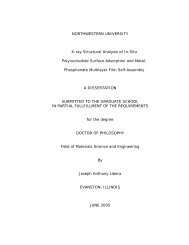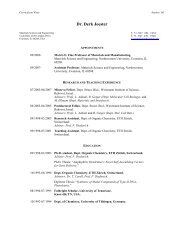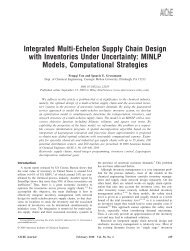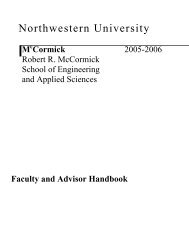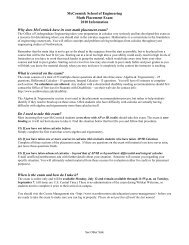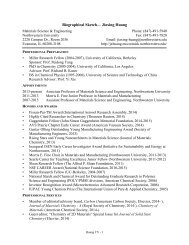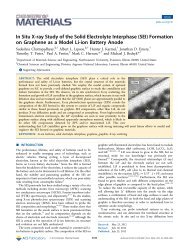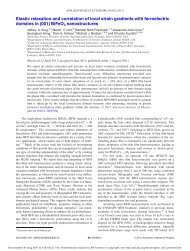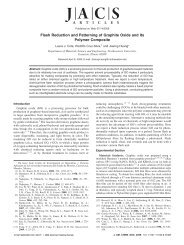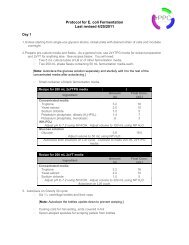Community-Based Operations Research - Humanitarian Logistics
Community-Based Operations Research - Humanitarian Logistics
Community-Based Operations Research - Humanitarian Logistics
You also want an ePaper? Increase the reach of your titles
YUMPU automatically turns print PDFs into web optimized ePapers that Google loves.
Johnson and Smilowitz: <strong>Community</strong>-<strong>Based</strong> <strong>Operations</strong> <strong>Research</strong>120 Tutorialsin <strong>Operations</strong><strong>Research</strong>, c○ 2007 INFORMS[9] J.J.Bartholdi, R.L.Collins, L.Platzman, and W.H.Warden.A minimal technology routingsystem for meals on wheels. Interfaces 13(3):1–8, 1983.[10] B.Beamon and S.Kotleba.Inventory modelling for complex emergencies in humanitarian reliefoperations. International Journal of <strong>Logistics</strong> 9(1):1–18, 2006.[11] A.Blumstein.An OR missionary’s visits to the criminal justice system.<strong>Operations</strong> <strong>Research</strong>55(2):14–23, 2007.[12] A.Blumstein, F.P.Rivara, and R.Rosenfeld.The rise and decline of homicide—and why.Annual Review of Public Health 21:505–541, 2000.[13] S.Bodily.Police sector design incorporating preferences of interest groups for equality andefficiency. Management Science 24(12):1301–1313, 1978.[14] R.Bowerman.A multi-objective optimization approach to urban school bus routing: Formulationand solution method. Transportation <strong>Research</strong> A 29A(2):107–123, 1995.[15] J.P.Brans and P.Vincke.A preference ranking organisation method (the PROMETHEEmethod for multiple criteria decision making). Management Science 31(6):647–656, 1985.[16] D.E.Brown and H.Liu.Criminal incident prediction using a point-pattern-based densitymodel. International Journal of Forecasting 19(4):603–622, 2003.[17] Bureau of Justice Statistics.Prison and jail inmates at midyear 2005.U.S.Department ofJustice, Office of Justice Programs. http://www.ojp.usdoj.gov/bjs/pub/pdf/pjim05.pdf, 2006.[18] A.Campbell, D.Vandenbussche, and W.Hermann.Routing in relief efforts.Working paper,University of Iowa, Ames, IA, 2006.[19] P.B.Checkland.The application of systems thinking in a real-world problem situation: Theemergence of soft systems methodology.M.C.Jackson and P.Keys, eds.New Directions inManagement Science.Gower, Aldershot, 87–96, 1987.[20] M.C.T.Chou and H.Zheng.Process flexibility revisited: Graph expander and food-from-theheart.Workingpaper, Business School, National University of Singapore, Singapore, 2005.[21] E.Erkut and S.R.Moran.Locating obnoxious facilities in the public sector: An application ofthe analytic hierarchy process to municipal landfill siting decisions. Socio-Economic PlanningSciences 25(2):89–102, 1991.[22] E.Erkut and S.Neuman.A multiobjective model for locating undesirable facilities.Annals of<strong>Operations</strong> <strong>Research</strong> 40:209–227, 1992.[23] D.Erlenkotter.Facility location with price-sensitive demands: Private, public, and quasipublic.Management Science 24(4):378–386, 1977.[24] G.A.Forgionne.Forecasting army housing supply with a DSS-delivered econometric model.Omega 24(5):561–576, 1996.[25] P.Francis, K.Smilowitz, and M.Tzur.The period vehicle routing problem with service choice.Transportation Science 40(4):439–454, 2006.[26] S.I.Gass.Public sector analysis and operations research/management science.S.M.Pollock,M.H.Rothkopf, and A.Barnett, eds.<strong>Operations</strong> <strong>Research</strong> in the Public Sector.North-Holland,Amsterdam, The Netherlands, 23–46, 1994.[27] B.Gates.Remarks.Washington learns educational summit.November 13, Seattle, WA,http://www.gates-foundation.org/MediaCenter/Speeches/Co-ChairSpeeches/BillgSpeeches/BGSpeechWashingtonLearns-061113.htm, 2006.[28] W.Gorr, M.Johnson, and S.Roehrig.Facility location model for home-delivered services:Application to the meals-on-wheels program. Journal of Geographic Systems 3:181–197, 2001.[29] Greater Chicago Food Depository and America’s Second Harvest.The national hunger study:Chicagoprofile.Chicago,IL.http://www.chicagosfoodbank.org/site/DocServer/HungerStudy 9.06.pdf?docID=301, 2005.[30] S.R.Gregg, J.M.Mulvey, and J.Wolpert.A stochastic planning system for siting and closingpublic service facilities. Environment and Planning A 20:83–98, 1988.[31] R.Gregory, H.Kunreuther, D.Easterling, and K.Richards.Incentives policies to site hazardouswaste facilities. Risk Analysis 11(4):667–675, 1991.[32] P.M.Griffin, C.R.Sherrer, and J.L.Swann.Optimization of community health center locationsand service offerings with statistical need estimation.Working paper, Georgia Instituteof Technology, School of Industrial and Systems Engineering, Atlanta, GA, 2006.[33] P.M.Griffin, C.R.Sherrer, and J.L.Swann.Access through community health centers orcoverage through medicaid: A geographical and mathematical analysis of the State of Georgia.Working paper, Georgia Institute of Technology, School of Industrial and Systems Engineering,Atlanta, GA, 2007.



